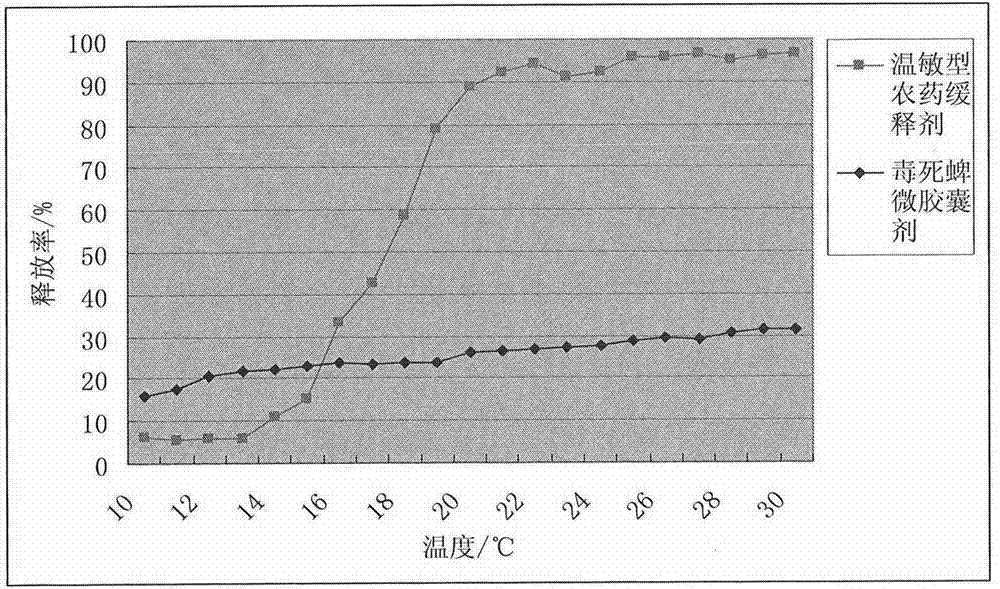Thermosensitive pesticide slow release agent for preventing and treating carposina niponensis walshingham
A peach borer, temperature-sensitive technology, applied in the direction of insecticide, application, biocide, etc., can solve economic waste, environmental pollution and other problems
- Summary
- Abstract
- Description
- Claims
- Application Information
AI Technical Summary
Problems solved by technology
Method used
Image
Examples
Embodiment 1
[0015] A temperature-sensitive pesticide sustained-release agent for the prevention and treatment of peach heartworm, which comprises the following components by mass: 0.8-1.3 parts of beta-cypermethrin, 0.4-1.0 parts of N-piperidine acrylamide, and hydroxypropyl methyl fiber 0.4-1.0 part of N-maleylated chitosan, 0.2-0.4 part of sodium persulfate, 0.2-0.4 part of sodium metabisulfite, 0.2-0.4 part of sodium lauryl sulfate and deionized water 35 -65 copies.
[0016] A method for processing the above-mentioned temperature-sensitive pesticide sustained-release agent for preventing and treating peach heartworm, including the following steps:
[0017] (1) 0.2-0.4 parts by mass of sodium lauryl sulfate is dissolved in 10-20 parts by mass of deionized water to obtain a mixed solution, and then the mixed solution is mixed with 0.8-1.3 at a rotation speed of 1500-3000 rpm. Mass parts of beta-cypermethrin are mixed to form a dispersion;
[0018] (2) 0.4-1.0 parts by mass of N-piperidine acr...
Embodiment 2
[0021] (1) Weigh 0.3 g of sodium lauryl sulfate and dissolve in 10 g of deionized water, and disperse 0.8 g of lambda cypermethrin in it at a rotation speed of 2000 rpm to form a dispersion liquid I.
[0022] (2) Weigh 0.650 g of N-piperidine acrylamide, 0.650 g of hydroxypropyl methyl cellulose, and 0.08 g of N-maleated chitosan to completely dissolve in 70.0 g of deionized water to form an aqueous solution II.
[0023] (3) After nitrogen is introduced into the aqueous solution II, 0.010 g of sodium metabisulfite, 0.012 g of sodium persulfate, and dispersion I are added to the aqueous solution II, sealed in a glass reaction vessel in a 60°C water bath for cross-linking polymerization, After continuous reaction for 5 hours, cool, rinse with deionized water, and vacuum-dry to constant weight to obtain.
[0024] The sustained-release effect of a temperature-sensitive slow-release agent of lambda cypermethrin obtained according to the steps in this example and the sustained-release effe...
PUM
 Login to View More
Login to View More Abstract
Description
Claims
Application Information
 Login to View More
Login to View More - R&D
- Intellectual Property
- Life Sciences
- Materials
- Tech Scout
- Unparalleled Data Quality
- Higher Quality Content
- 60% Fewer Hallucinations
Browse by: Latest US Patents, China's latest patents, Technical Efficacy Thesaurus, Application Domain, Technology Topic, Popular Technical Reports.
© 2025 PatSnap. All rights reserved.Legal|Privacy policy|Modern Slavery Act Transparency Statement|Sitemap|About US| Contact US: help@patsnap.com



